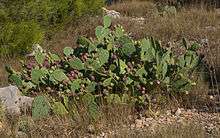Opuntia stricta
| Opuntia stricta | |
|---|---|
_03_ies.jpg) | |
| Opuntia stricta in fruit, Canary Islands. | |
| Scientific classification | |
| Kingdom: | Plantae |
| (unranked): | Angiosperms |
| (unranked): | Eudicots |
| (unranked): | Core eudicots |
| Order: | Caryophyllales |
| Family: | Cactaceae |
| Genus: | Opuntia |
| Species: | O. stricta |
| Binomial name | |
| Opuntia stricta (Haw.) Haw.[1] | |
| Varieties | |
|
O. s. var. dillenii (Ker Gawl.) L.D.Benson | |
| Synonyms | |
|
See text. | |
Opuntia stricta is a species of cactus from southern North America, Central America, the Caribbean, and northern South America.[1] Common names include erect prickly pear and nopal estricto (Spanish).[2]
It is an erect or sprawling shrub up to 2 m (6.6 ft) in height, producing lemon yellow flowers in the spring and summer, followed by purplish-red fruits.
Distribution
Opuntia stricta occurs naturally in Texas, Alabama, Georgia, Mississippi, Florida and South Carolina in the United States as well as the Bahamas, Bermuda, the Caribbean, eastern Mexico, Central America, northern Venezuela, and Ecuador.
Invasive species

It has been introduced to many parts of the world, including Africa, Southern Europe, and southern Asia. O. stricta is considered an invasive species in South Africa. In Australia it has been the subject of one of the first really effective biological control exercises using the moth Cactoblastis cactorum.[1] It was declared a Weed of National Significance by the Australian Weeds Committee in April 2012, but continues to be kept under control by the use of the Cactoblastis moth and a cochineal insect, Dactylopius opuntiae.
In Sri Lanka it has overgrown a 30 kilometer long coastal area between Hambantota and Yala National Park, especially in Bundala National Park, a Ramsar wetland site. It has overgrown several hundreds of hectares of sand dune areas and adjoining scrub forests and pasture lands. Some areas are so densely covered that they are completely inaccessible for humans and animals. The seeds are spread by macaque monkeys, and perhaps other animals and birds, that eat the large fruits. It is also spread by people cutting down the cactus but leaving the cuttings, which then re-sprout where they have fallen. No control measures have been carried out except some costly manual removal of about 10 hectares on the dunes near Bundala village. The cactus is due to invade Yala National Park.[3]
Synonyms
- Cactus dillenii Ker Gawl.
- Cactus strictus Haw.
- Opuntia dillenii (Ker Gawl.) Haw.
- Opuntia vulgaris var. balearica
- Raketa Mena Madagascar
See also
References
- 1 2 3 4 "Opuntia stricta (Haw.) Haw.". Germplasm Resources Information Network. United States Department of Agriculture. 2003-08-29. Retrieved 2009-12-05.
- 1 2 "Opuntia stricta (Haw.) Haw.". ITIS Standard Report. Integrated Taxonomic Information System. Retrieved 2009-12-03.
- ↑ Lalith Gunasekera, Invasive Plants: A guide to the identification of the most invasive plants of Sri Lanka, Colombo 2009, p. 84–85. A biodiversity status profile of Bundala National Park : a Ramsar national wetland of Sri Lanka Bambaradeniya, Channa N.B. ; Ekanayake, S.P. ; Fernando, R.H.S.S. ; Perera, W.P.N. ; Somaweera, R. Colombo : IUCN Sri Lanka, 2002. ISBN 955-8177-16-4.
External links
| Wikimedia Commons has media related to Opuntia stricta. |
- Flora of North America: Opuntia stricta
- United States Department of Agriculture PLANTS Profile: Opuntia stricta